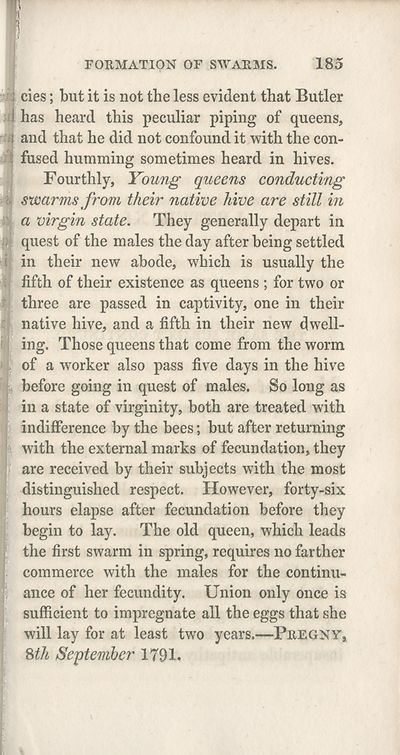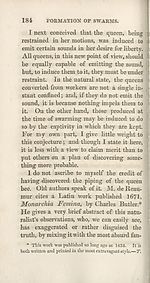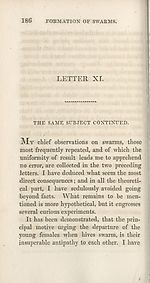Download files
Complete book:
Individual page:
Thumbnail gallery: Grid view | List view

FORMATION OF SWARMS.
185
cies; but it is not the less evident that Butler
has heard this peculiar piping of queens,
and that he did not confound it with the con¬
fused humming sometimes heard in hives.
Fourthly, Young queens conducting
swarms from their native hive are still in
a virgin state. They generally depart in
I quest of the males the day after being settled
in their new abode, which is usually the
fifth of their existence as queens ; for two or
three are passed in captivity, one in their
native hive, and a fifth in their new dwell¬
ing. Those queens that come from the worm
of a worker also pass five days in the hive
before going in quest of males. So long as
in a state of virginity, both are treated with
indifference by the bees; but after returning
with the external marks of fecundation, they
are received by their subjects with the most
distinguished respect. However, forty-six
hours elapse after fecundation before they
begin to lay. The old queen, which leads
the first swarm in spring, requires no farther
commerce with the males for the continu¬
ance of her fecundity. Union only once is
sufficient to impregnate all the eggs that she
will lay for at least two years.—Pregny,
%th September 1791.
185
cies; but it is not the less evident that Butler
has heard this peculiar piping of queens,
and that he did not confound it with the con¬
fused humming sometimes heard in hives.
Fourthly, Young queens conducting
swarms from their native hive are still in
a virgin state. They generally depart in
I quest of the males the day after being settled
in their new abode, which is usually the
fifth of their existence as queens ; for two or
three are passed in captivity, one in their
native hive, and a fifth in their new dwell¬
ing. Those queens that come from the worm
of a worker also pass five days in the hive
before going in quest of males. So long as
in a state of virginity, both are treated with
indifference by the bees; but after returning
with the external marks of fecundation, they
are received by their subjects with the most
distinguished respect. However, forty-six
hours elapse after fecundation before they
begin to lay. The old queen, which leads
the first swarm in spring, requires no farther
commerce with the males for the continu¬
ance of her fecundity. Union only once is
sufficient to impregnate all the eggs that she
will lay for at least two years.—Pregny,
%th September 1791.
Set display mode to:
![]() Universal Viewer |
Universal Viewer | ![]() Mirador |
Large image | Transcription
Mirador |
Large image | Transcription
| Antiquarian books of Scotland > Curiosities & wonders > New observations on the natural history of bees > (203) |
|---|
| Permanent URL | https://digital.nls.uk/128808303 |
|---|
| Description | Thousands of printed books from the Antiquarian Books of Scotland collection which dates from 1641 to the 1980s. The collection consists of 14,800 books which were published in Scotland or have a Scottish connection, e.g. through the author, printer or owner. Subjects covered include sport, education, diseases, adventure, occupations, Jacobites, politics and religion. Among the 29 languages represented are English, Gaelic, Italian, French, Russian and Swedish. |
|---|

